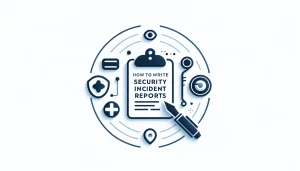Why do security officers need to report incidents and accidents?
Security officers are responsible for maintaining the safety and security of people and property in their assigned areas. Reporting incidents and accidents is an essential part of their role because it helps to ensure that any safety or security risks are identified and addressed promptly.

There are several reasons why security officers need to report incidents and accidents:
- Identification of safety and security risks – Reporting incidents and accidents helps to identify safety and security risks that may have gone unnoticed. This enables security officers to take the necessary steps to address these risks and prevent future incidents from occurring.
- Documentation of incidents – Documenting incidents and accidents creates a record that can be used to investigate and analyze the causes of the incident. This information can be used to identify trends and patterns that can help to prevent future incidents from occurring.
- Compliance with legal and regulatory requirements – Reporting incidents and accidents is often a legal or regulatory requirement. Compliance with these requirements is essential to avoid penalties and maintain a safe and secure environment.
- Protection of people and property – Reporting incidents and accidents helps to protect people and property by providing information that can be used to take appropriate action. This includes notifying law enforcement, emergency services, and other relevant authorities when necessary.
Overall, reporting incidents and accidents is a critical part of a security officer’s role. By reporting these events, security officers can help to maintain a safe and secure environment, protect people and property, and ensure compliance with legal and regulatory requirements.
What information should be included in a security incident report?
A security incident report should include the following information:
- Date and time of the incident – The date and time of the incident should be recorded accurately to help establish a timeline of events.
- Location of the incident – The location of the incident should be described in detail to help identify any patterns or trends in security incidents in that area.
- Description of the incident – A detailed description of the incident should be included, including what happened, who was involved, and any actions taken in response to the incident.
- Witnesses – Any witnesses to the incident should be identified and their contact information recorded.
- Injuries or damages – If there were any injuries or damages resulting from the incident, they should be documented in detail.
- Security equipment and procedures – Any security equipment or procedures that were in place at the time of the incident should be documented, including any malfunctions or deficiencies.
- Follow-up actions – Any follow-up actions taken in response to the incident should be documented, including any repairs or improvements to security equipment or procedures.
- Recommendations – Any recommendations for improving security in the future should be included, based on the findings from the incident.
- Signature – The report should be signed and dated by the security officer who prepared it.
It is important to ensure that the report is accurate, concise, and objective, and that any information included is relevant to the incident being reported. A well-written security incident report can provide valuable information for analysis and can help to prevent similar incidents from occurring in the future.
What is RIDDOR?
RIDDOR stands for the Reporting of Injuries, Diseases and Dangerous Occurrences Regulations. It is a set of regulations that requires employers and other responsible parties to report certain types of incidents that occur in the workplace to the relevant health and safety authorities.
RIDDOR applies to all employers, the self-employed, and those in control of premises. The regulations require that certain types of incidents be reported, including:
- Work-related deaths
- Serious injuries or accidents
- Cases of work-related diseases
- Dangerous occurrences
In addition to the above, RIDDOR also requires that accidents involving members of the public on work premises be reported, as well as any incidents that lead to a person being taken to the hospital for treatment.
Reporting incidents under RIDDOR is an important part of maintaining workplace safety and health. It allows health and safety authorities to collect data on incidents and trends, identify potential hazards, and take action to prevent future incidents from occurring. It also helps to ensure that employees receive appropriate care and compensation for any injuries sustained while at work.
If an incident occurs that meets the criteria for reporting under RIDDOR, it must be reported within a specified timeframe. The process for reporting varies depending on the type of incident, but generally involves completing a report and sending it to the appropriate health and safety authority.